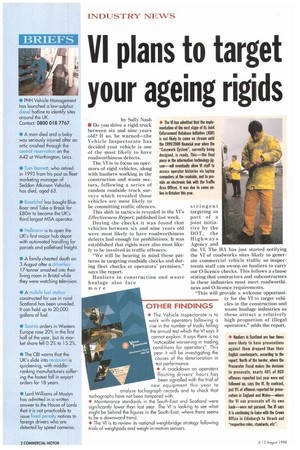VI plans to target your ageing rigids
Page 4

If you've noticed an error in this article please click here to report it so we can fix it.
by Sally Nash III Do you drive a rigid truck between six and nine years old? If so, be warned—the Vehicle Inspectorate has decided your vehicle is one of the most likely to have roadworthiness defects.
The VI is to focus on operators of rigid vehicles, along with hauliers working in the construction and waste sectors, following a series of random roadside truck surveys which revealed those vehicles are most likely to be committing traffic offences.
This shift in tactics is revealed in the VI's Effectiveness Report, published last week.
During the checks it was found that vehicles between six and nine years old were most likely to have roadworthiness defects bad enough for prohibitions. It was established that rigids were also most likely to be involved in traffic offences.
"We will be bearing in mind these patterns in targeting roadside checks and during fleet checks at operators' premises," says the report.
Hauliers in construction and waste haulage also face more
stringent targeting as part of a joint initiative by the DOT, the Highways Agency and the VI. The HA has just started notifying the VI of roadworks sites likely to generate commercial vehicle traffic so inspectorate staff can swoop on hauliers to carry out 0-licence checks. This follows a clause stating that contractors and subcontractors in these industries must meet roadworthiness and 0-licence requirements,
"This will provide a welcome opportunity for the Vi to target vehicles in the construction and waste haulage industries as these attract a relatively high proportion of illegal operators," adds the report.
• Hauliers in Scotland are four times more likely to have prosecutions against them dropped than their English counterparts, according to the report. North of the border, where the Procurator Fiscal makes the decision to prosecute, nearly 40% of HO offences reported last year were not followed up, says the VI. By contrast, just Pc of offences reported for prosecution in England and Wales—where the VI can prosecute off its own back—were not pursued. The VI says it is continuing to liaise with the Crown Office in Edinburgh to thrash out "respective roles, standards, etc". 46. The VI has admitted that the implementation of the next stage of its Joint Enforcement Database Initiative (lE111) is not likely to come on stream until the 1999/2000 financial year when the "Casework System". currently being designed, is ready. This—the final piece in the information technology jigsaw—will eventually allow VI staff to access operator histories via laptop computers at the roadside, and to provide an electronic link with the Traffic Area Offices. It was due to come onfine in October this year.












































































































